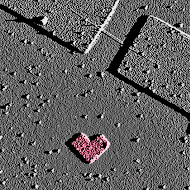If we heat or cool an object we observe a change in its volume. This is due to the thermal expansion, and is described by the thermal expansion coefficient. It describes how the volume changes with temperature.
In the typical 3D solids if we heat up the size of the object will increase (easy!). That behavior is due to increasing of the energy. If we add energy to the system, the vibrations of the lattice atoms become more significant and the average distance between the atoms increases, which in the end contributes to the bigger volume/length of the system. As an easy example think of railway tracks getting deformed during hot, summer days.
Now the situation in 1D and 2D systems is totally different. Measurements were first done on graphene with SEM microscopy and Raman spectroscopy, both of them showing a negative thermal expansion coefficient. That means, that unlike the typical materials graphene contracts with increasing temperature. The negative thermal expansion coefficient was estimated to be rather large 8x 10^-6 1/K.
Then in our work we extracted the thermal expansion coefficient for single-walled carbon nanotubes. Because the nanotubes are so small, and the thermal expansion even smaller, we couldn't measure it directly. Instead we measured the shifts in resonance frequency of a nanotube resonator, which we then related to the change in tension of the nanotube. Taking into account the elongation imposed by contracting gold electrodes and substrate, we could determine the expansion coefficient of a nanotube. This is also negative and relatively large.
What is the reason behind negative thermal expansion of 1 and 2D objects?
This is a simple explanation offered by my ex-boss Adrian Bachtold. At 0 K temperature (so called absolute zero) there are no phonon modes in the sample, so you can imagine it laying completely flat on the surface, with a given length L0. Then if you increase the temperature there are more and more phononic modes, especially the flexural modes which are responsible for deforming the sample. If you then project the length on the sample LT on the surface it will appear shorter.















